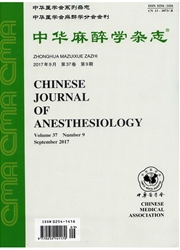

 中文摘要:
中文摘要:
目的探讨丝氨酸-苏氨酸激酶(Akt)/糖原合成酶激酶.3G(Akt/GSK-3β)信号转导通路在小鼠神经病理性痛中的作用。方法雄性C57BL/6小鼠36只,体重20—25g,7—8周龄,采用随机数字表法,将其随机分为2组:假手术组(s组,n=9)和神经病理性痛组(CCI组,n=27)。CCI组采用坐骨神经慢性结扎损伤的方法制备神经病理性痛模型,s组行假手术。2组取6只小鼠,分别于CCI前1d、CCI后1、3、5、7、10、14、17、21d时测定机械缩足阈值(PWMT)和热缩足潜伏期(PWTL)。S组于造模后3d,CCI组于CCI后1、3、5、7、10、14、21d时处死3只小鼠,取L3-5段脊髓,采用Western blot法检测Akt、磷酸化Akt(p-Akt)和磷酸化GSK-3β(β—GSK-3β)的表达。结果与S组比较,CCI组CCI后1~21dPWMT降低,PWTL缩短,CCI后7~21d时脊髓Akt表达上调,CCI后1~21d时脊髓p-Akt和p-GSK-3β表达上调(P〈0.05)。结论Akt/GSK-3β信号转导通路参与了小鼠神经病理性痛的形成和维持。
 英文摘要:
英文摘要:
Objective To investigate the role of Akt/glycogen synthase kinase-3β (GSK-3β) signaling pathway in neuropathic pain in mice.Methods Thirty-six male C57BL/6 mice, aged 7-8 months,weighing 20-25 g, were randomly divided into 2 groups: sham operation group (group S, n = 9) and chronic constrictive injury (CCI) group ( n = 27). CCI was produced by placing loosely constrictive ligatures around the common sciatic nerve. Six animals were taken from each group and paw withdrawal threshold to mechanical stimulation (PWMT) and paw withdrawal latency to thermal stimuli (PWTL) were measured on day 1 before operation and on day 1, 3, 5, 7, 10, 14, 17 and 21 after CCI. Three mice were sacrificed on day 3 after CCI in group S and on day 1, 3, 5, 7, 10, 14 and 21 after CCI in group CCI. The L3-5 segment of the spinal cord was removed for determination of the expression of Akt, phospho-Akt and phospho-GSK-3β by Western blot. Results Compared with group S, PWMT was significantly decreased and PWTL was significantly shortened on day 1-21 after CCI, the expression of Akt was significantly up-regulated on day 7-21 after CCI, and the expression of phospho-Akt and phospho-GSK-3β was significantly up-regulated on day 1-21 after CCI in group CCI ( P 〈 0.05). Conclusion Akt/GSK-3β signaling pathway is involved in the development and maintenance of neuropathic pain in mice.
 同期刊论文项目
同期刊论文项目
 同项目期刊论文
同项目期刊论文
 Intrathecal Administration of the Cannabinoid 2 Receptor Agonist JWH015 Can Attenuate Cancer Pain an
Intrathecal Administration of the Cannabinoid 2 Receptor Agonist JWH015 Can Attenuate Cancer Pain an The respective and interaction effects of spinal GRs and MRs on radicular pain induced by chronic co
The respective and interaction effects of spinal GRs and MRs on radicular pain induced by chronic co Intrathecal injection of metabotropic glutamate receptor subtype 3 and 5 agonist/antagonist attenuat
Intrathecal injection of metabotropic glutamate receptor subtype 3 and 5 agonist/antagonist attenuat Activation of mTOR in the spinal cord is required for pain hypersensitivity induced by chronic const
Activation of mTOR in the spinal cord is required for pain hypersensitivity induced by chronic const Intrathecal Injection of JWH-015 Attenuates Bone Cancer Pain Via Time-Dependent Modification of Pro-
Intrathecal Injection of JWH-015 Attenuates Bone Cancer Pain Via Time-Dependent Modification of Pro- Dexmedetomidine prevents remifentanil-induced postoperative hyperalgesia and decreases spinal tyrosi
Dexmedetomidine prevents remifentanil-induced postoperative hyperalgesia and decreases spinal tyrosi Intrathecal Injection of the Peptide Myr-NR2B9c Attenuates Bone Cancer Pain Via Perturbing N-Methyl-
Intrathecal Injection of the Peptide Myr-NR2B9c Attenuates Bone Cancer Pain Via Perturbing N-Methyl- Activation of GRs-Akt-nNOs-NR2B signaling pathway by second dose GR agonist contributes to exacerbat
Activation of GRs-Akt-nNOs-NR2B signaling pathway by second dose GR agonist contributes to exacerbat 期刊信息
期刊信息
